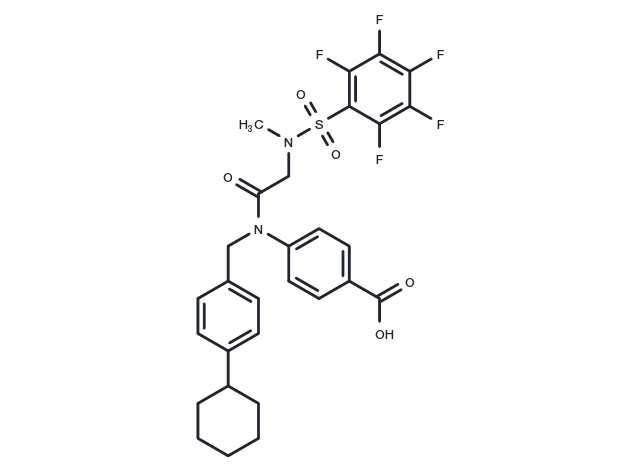Powder: -20°C for 3 years | In solvent: -80°C for 1 year


SH-4-54 is a most potent, small molecule, nonphosphorylated STAT3 inhibitor.

| Pack Size | Availability | Price/USD | Quantity |
|---|---|---|---|
| 1 mg | In stock | $ 43.00 | |
| 2 mg | In stock | $ 61.00 | |
| 5 mg | In stock | $ 97.00 | |
| 10 mg | In stock | $ 163.00 | |
| 25 mg | In stock | $ 328.00 | |
| 50 mg | In stock | $ 528.00 | |
| 100 mg | In stock | $ 769.00 | |
| 1 mL * 10 mM (in DMSO) | In stock | $ 137.00 |



| Description | SH-4-54 is a most potent, small molecule, nonphosphorylated STAT3 inhibitor. |
| Targets&IC50 | STAT3:300 nM(Kd), STAT5:464 nM(Kd) |
| In vitro | SH-4-54 effectively inhibits the phosphorylation of STAT3 and its downstream transcription targets. Additionally, SH-4-54 demonstrates unparalleled cytotoxicity against human malignant gliomas and liver cancer cells while showing no toxicity toward human embryonic astrocytes. |
| In vivo | Intraperitoneal injection of 10 mg/kg SH-4-54 into mice with orthotopic xenografts of BT73 effectively inhibited the growth of glioma and suppressed pSTAT3 activation. |
| Kinase Assay | Surface Plasmon Resonance (SPR) studies: The binding experiments are carried out on a ProteOn XPR36 biosensor at 25°C using the HTE sensor chip. The flow cells of the sensor chip are loaded with a nickel solution at 30 μL/min for 120 s to saturate the Tris–NTA surface with Ni(II) ions. Purified His-tagged STAT3 and STAT5 in PBST buffer (PBS with 0.005% (v/v) Tween-20 and 0.001% DMSO pH 7.4) is injected in the first and second channels of the chip respectively in the vertical direction at a flow rate of 25 μg/μL for 300 s, which attained, on average, ~8000 resonance unit (RU). After a wash with PBST buffer, inhibitors binding to the immobilized proteins is monitored by injecting a range of concentrations along with a blank at a flow rate of 100 μL/min for 200 s for each of these small molecules. When the injection of the small molecule inhibitor is completed, running buffer is allowed to flow over the immobilized substrates for the non-specifically bound inhibitors to dissociate for 600 s. Following dissociation of the inhibitors, the chip surface is regenerated with an injection of 1 M NaCl at a flow rate of 100 μL/ml for 18 s. Interspot channel reference is used for non-specific binding corrections and the blank channel used with each analyte injection served as a double reference to correct for possible baseline drift. Data are analyzed using ProteOn Manager Software version 3.1. The Langmuir 1:1 binding model was used to determine the KD values. |
| Cell Research | BTSC spheres are dissociated to single cells with the enzyme Accumax, seeded at 1500 cells/ 96-well and treated with drug or vehicle (DMSO) one day after plating. Cytotoxicity studies are repeated independently using BTSC lines 25M, 67EF, 73EF, 84EF and 127EF. BTSC spheres are dissociated to single cells as above and plated in 96 well plates in triplicate at 3000 cells/ 96-well. In both sets of experiments drugs are used as serial dilutions within the range of 5 μM to 100 nM in the first set and 25 μM to 10 nM. Cell viability following drug treatment is assessed three days later using the alamarBlue assay according to the manufacturer's instructions. All culture experiments are performed in triplicate with a minimum of three wells per condition.(Only for Reference) |
| Molecular Weight | 610.59 |
| Formula | C29H27F5N2O5S |
| CAS No. | 1456632-40-8 |
Powder: -20°C for 3 years | In solvent: -80°C for 1 year
DMSO: 93 mg/mL (152.3 mM)
H2O: < 1 mg/mL (insoluble or slightly soluble)
Ethanol: 47 mg/mL (77 mM)
You can also refer to dose conversion for different animals. More
bottom
Please see Inhibitor Handling Instructions for more frequently ask questions. Topics include: how to prepare stock solutions, how to store products, and cautions on cell-based assays & animal experiments, etc.
SH-4-54 1456632-40-8 JAK/STAT signaling Stem Cells STAT SH 4 54 Inhibitor SH454 inhibit inhibitor
